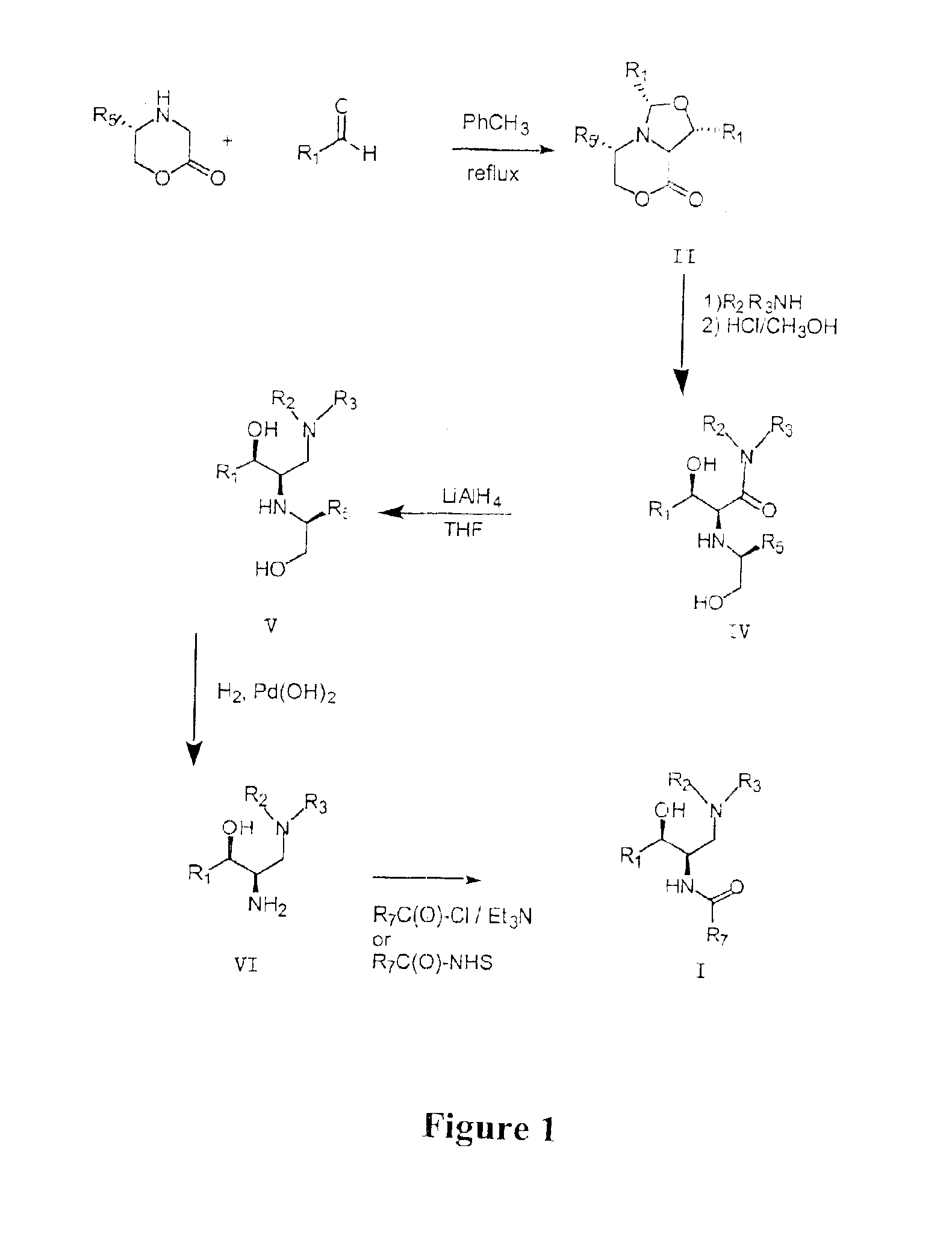Synthesis of UDP-glucose: N-acylsphingosine glucosyltransferase inhibitors
a technology of acylsphingosine and glucosyltransferase, which is applied in the field of synthesis of udpglucose, can solve the problems that the known methods of preparing amino ceramide-like compounds are poorly suited for industrial production
- Summary
- Abstract
- Description
- Claims
- Application Information
AI Technical Summary
Benefits of technology
Problems solved by technology
Method used
Image
Examples
example 1
Small Scale Preparation of Ceramid-Like Compounds
Intermediate 1
(1R,3S,5S,8aS)-1,3-Bis-(2′,3′-dihydro-benzo[1,4]dioxin-6′-yl)-5-phenyl-tetrahydro-oxazolo[4,3-c][1,4]oxazin-8-one
To a stirred solution of (5S)-5-phenylmorpholim-2-one (2.00 g, 11.3 mmol) (prepared as in: Dellaria, J. F.: Santarsiero, B. D. J. Org. Chem., 1989, 54, 3916) and 1,4-benzodioxan-6-carboxaldehyde (5.56 g, 33.9 mmol) in toluene (125 mL) was added 4 Å molecular sieves (approximately 20 mL). The mixture was heated at reflux for 72 hours, filtered free of sieves and concentrated. The resulting amber gum was flash chromatographed over silica (diethyl ether / hexane) to furnish a pale yellow solid. This material was further purified by trituration with diethyl ether to afford 1.89 g (34%) product as a fluffy white solid: 1H NMR (CDCl3) δ 7.31-7.17 (m, 5H), 6.95-6.79 (m, 5H), 5.32-5.27 (m, 2H), 4.43-4.28 (m, 2H), 4.24 (s, 4H), 4.18 (m, 4H), 4.16-4.08 (m, 2H) ppm.
Intermediate 2
(2S,3R,1″S)-3-(2′,3′-Dihydro-benzo [1,4]diox...
example 2
Large Scale Preparation of Ceramide-Like Compounds
(5S)-5-Phenylmorpholin-2-One
A solution of S-(+)-Phenyl glycinol (Aldrich, 10.17 g, 78.12 mmol) and Diusopropylethylamine (Aldrich, 34 mL, 195 mmol, 2.5 equivalents) was prepared in CH3CN (200 mL). This solution was added to phenyl-α-bromoacetate (18.48 g, 85.9 mmol, 1.1 equivalents) dissolved in CH3CN (50 mL) under nitrogen dropwise over 2 hours. The resulting solution was stirred under nitrogen for 16-20 hours. The solvent was removed by rotoevaporation keeping the bath temperature at below 25° C. To the oil was added ethyl acetate (120 mL) and the mixture was stirred for 15 minutes. The resulting white precipitate was filtered off and the solid washed with ethyl acetate (25 mL). The filtrate was rotoevaporated to an oil keeping the bath temperature below 25° C. After drying under vacuum for 0.5 hours, the oil was dissolved in CH2Cl2 (17 mL) and loaded onto a silica gel column (60 g packed with 10% ethyl acetate / hexanes. The upper b...
example 3
Alternative Large Scale Preparation of Ceramide-Like Compounds
(5S)-5-Phenylmorpholin-2-one HCl salt
A solution of phenyl bromoacetate (Aldrich, 862.17 g, 4.0 moles, 1.1 equivalents) in acetonitrile (reagent grade, 1500 ml) was cooled in an ice bath (internal temperature below 5° C.). To this was added a cold slurry (internal temperature below 5° C.) of S-(+)-2-phenyl glycinol (Aldrich, 500 g, 3.65 moles, 1 equivalent) and diisopropylethylamine (DIPEA) (Aldrich, 1587 ml, 9.11 moles, 2.5 equivalents) in acetonitrile (2900 ml) in portions while keeping the internal temperature below 10° C. The mixture was stirred at this temperature for 30 minutes before the ice bath was removed and the mixture was allowed to stir at room temperature for an additional 4 hours. The solvent was removed in vacuo while maintaining the bath temperature at 25° C. The mixture was coevaporated with ethyl acetate (2×500 ml) to produce a light yellow viscous oil. To the reaction mixture, ethyl acetate (4500 ml) w...
PUM
| Property | Measurement | Unit |
|---|---|---|
| adhesion | aaaaa | aaaaa |
| structure | aaaaa | aaaaa |
| concentrations | aaaaa | aaaaa |
Abstract
Description
Claims
Application Information
 Login to View More
Login to View More - R&D
- Intellectual Property
- Life Sciences
- Materials
- Tech Scout
- Unparalleled Data Quality
- Higher Quality Content
- 60% Fewer Hallucinations
Browse by: Latest US Patents, China's latest patents, Technical Efficacy Thesaurus, Application Domain, Technology Topic, Popular Technical Reports.
© 2025 PatSnap. All rights reserved.Legal|Privacy policy|Modern Slavery Act Transparency Statement|Sitemap|About US| Contact US: help@patsnap.com



